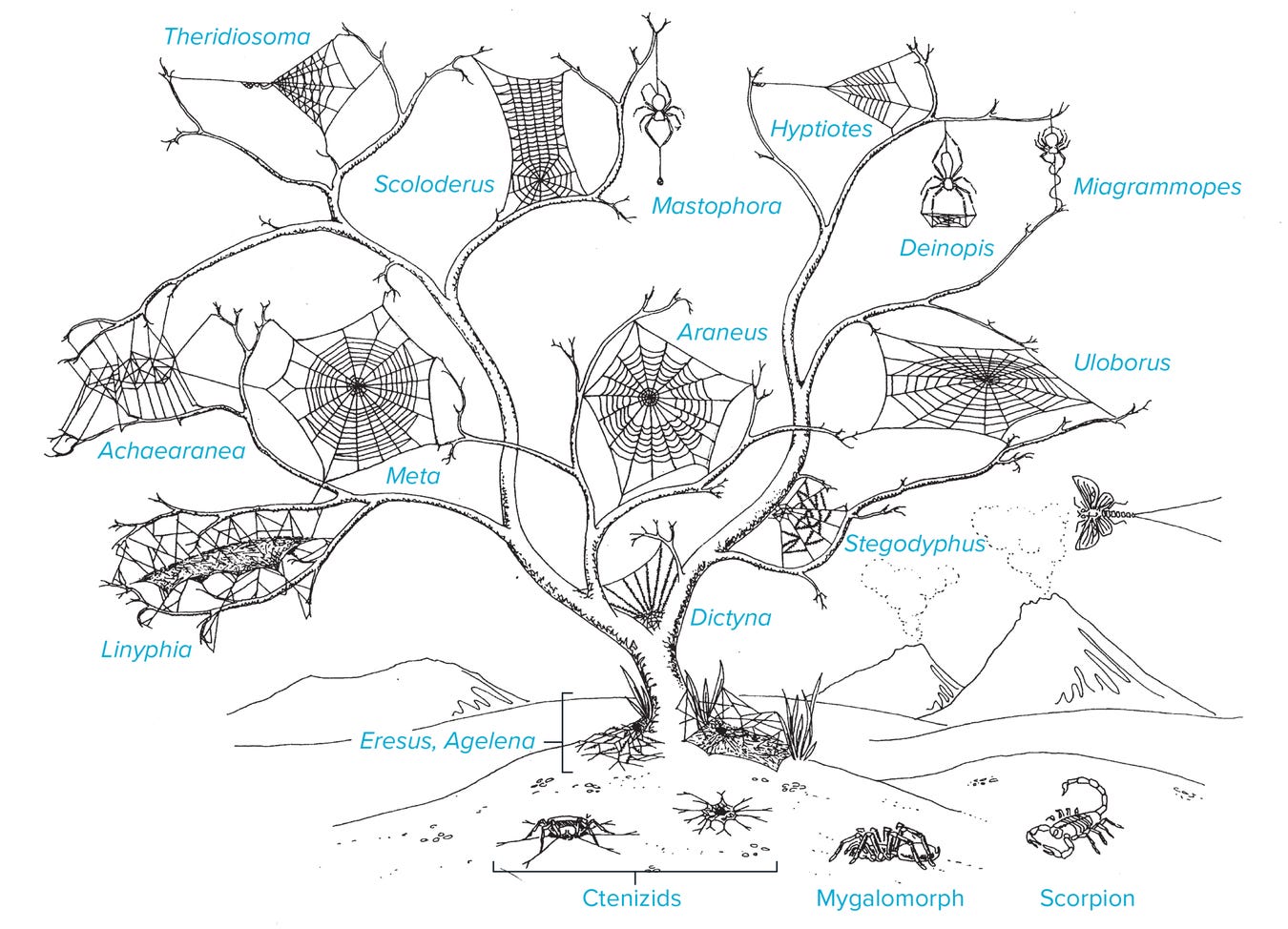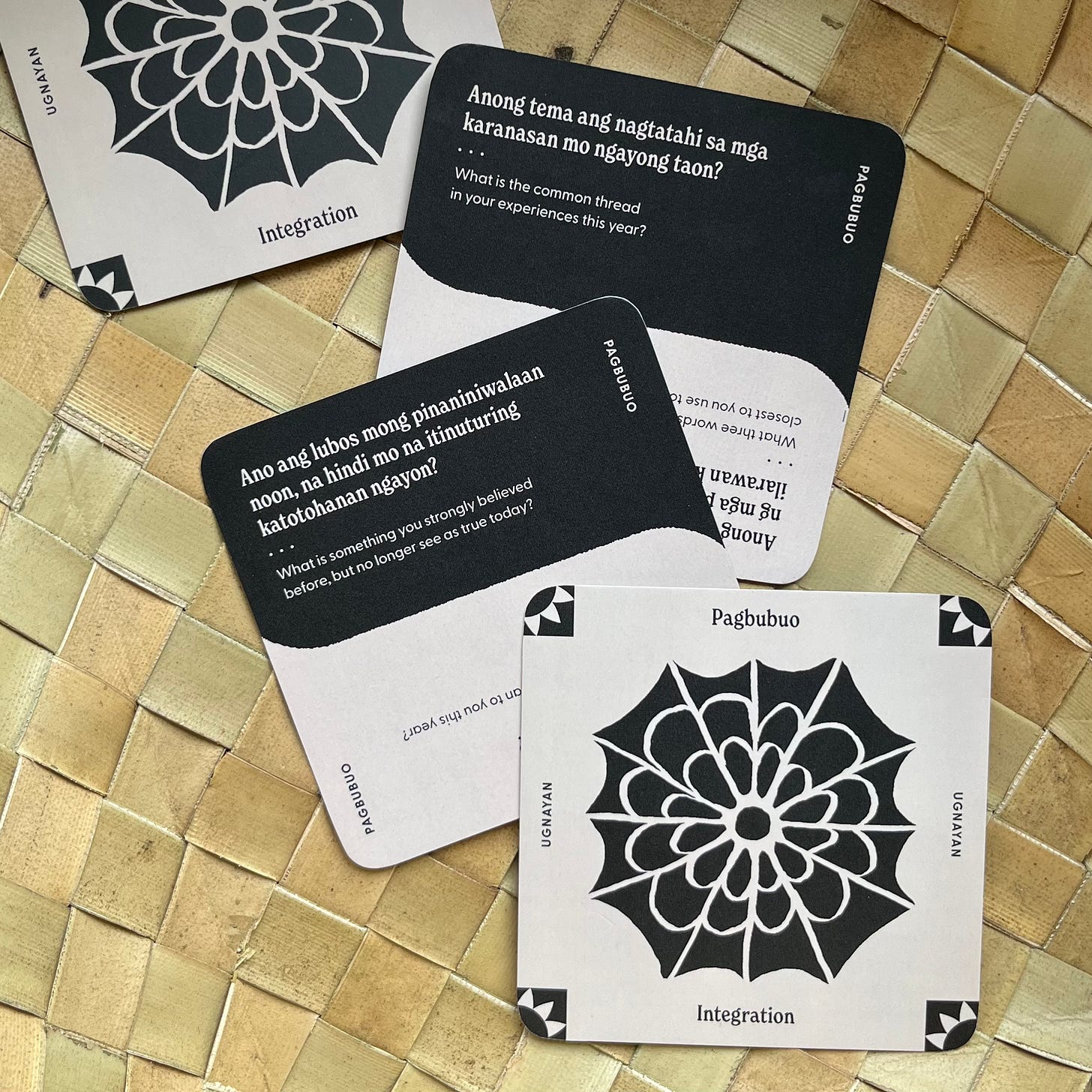Pagbubuo: Integrating our parts towards wholeness
What does "buo" look like in this season of your life? And how might we recognize our wholeness while we weave the stories of who we are becoming?
Hi, ka-Ugnayan,
Jen here, checking in / out for our last Liham ng Ugnayan for the year.
Just like that, 2024 is now coming to a close. We’re celebrating a full cycle of Ugnayan Cards’ 12 wellbeing themes as we culminate with Pagbubuo or Integration, represented by the image of a web.
Pagbubuo
(Tagalog) Ang proseso ng pagsama-sana ng iba’t ibang bahagi upang maging kumpleto o buo
(English) The process of combining or integrating different parts towards completion or wholeness
Bu•o (adjective) whole; complete
Bu•o (verb) make whole; create; develop; build; integrate
Join me in diving deeper into these questions:
Ano yung binuo mo ngayong taon (maging sadya man o hindi)? | What did you work to create this year (intentionally or unintentionally)?
Ano ang kahulugan at itsura ng pagiging “buo” para sa akin ngayong taon? | What does "buo" mean or look like to me this year?
Paano ko kinikilala ang pagkabuo ko habang hinahabi pa ang tela at “telos” ng aking nais maging? | How do I recognize my wholeness while weaving the fabric and “telos” of who I am becoming?1
1. Pagbubuo sa Kalikasan (Nature)
We see the process of pagbubuo happening in nature in a number of ways — from creatures big and small. We see how birds build their nests, bees their hives, ants their anthills, and so on. Entire ecosystems are formed by the contributions of every living being — from the forest floor (and underground) to the tops of its canopies.
We also specifically look to spiders, who masterfully spin their silk to protect their eggs, create underwater homes, and most popularly, capture their prey, in architecturally diverse and aesthetic ways.2

Similarly, we each have our own webs that we’re weaving in our own lives. While we’ve been influenced by our true nature and external environment, we still get to decide the shapes we’d like to make. We get to write our stories the way we want to — with all the triumphs and challenges, barriers and setbacks (both real and imagined).
Ano yung binuo mo ngayong taon (maging sadya man o hindi)? | What did you work to create this year (intentionally or unintentionally)?
What surprised you about it or how you created it?
What felt authentically you about it?
In what ways did this positively affect others?
What might make this more intentional?
2. Ang Diwa ng Pagbubuo
While Pagbubuo was not a theme I often picked in my own Ugnayan Cards reflections this year, it is a theme that is close to my heart. “Buo” is the word that got me started with a more regular writing practice on jenhorn.substack.com three years ago, and inspired me to create my @pagbubuo account on Instagram in January 2023.
A couple of months ago, I revisited what “pagbubuo” means to me, and I’m pleased with what remains true to my core, but also with how some once aspired-for-philosophies have become more embodied over time.3
Ako’y buo habang nagbubuo.
The living portfolio of my life is whole while continuing to evolve with me.
Nabubuo tayo sa pagkilala ng ating kalahatan.
The mess, the mayhem, the magic and the mundane -- all that is me.Magkakapit-bisig ang pagbuo at pagwasak.
Our greatest growth can stem from un-becoming and re-learning.Nabubuo ang sarili sa pakikipag-ugnayan sa kapwa.
The self-made person is a myth.Ang pagbubuo ng buhay ay isang gawa ng paglikha.
We imagine, create, and shape our lives by our own design.Sa paglikha lumilinaw ang ating minimithi.
Creative expression allows our deepest desires for ourselves and those around us to emerge.
Bahagi ng pagbubuo ang pagpapahinga.
There are seasons to germinate and to blossom; to cocoon and to transform.
Kasama tayo sa pagbubuo ng nais nating kultura.
We play a part in perpetuating oppression as well as cultivating co-liberation.
I feel like each “pagbubuo-ism” or philosophy could unearth so much more when we reflect on them. Which one most deeply resonates with you right now?
The below are questions we can chew on at the end of the year, or at the start of a new one as we reflect on this theme. Feel free to share these with a group of friends you might want to gather, reflect, dream and co-create with.
Ano ang kahulugan at itsura ng pagiging “buo” para sa akin ngayong taon? | What does "buo" mean or look like to me this year?
If I were to weave past, present and future:
What were the greatest lessons that I learned throughout the year?
In what ways was I transformed by these experiences?
What do I want to carry over from these lessons to the year ahead?
If I were to weave mind, body, heart and spirit:
In what ways did I nurture learning and growth, health, relationships with myself, others and the more-than-human world?
How am I seeing these parts as more connected rather than separate?
What do I want to do more of? What do I want to do differently?
Aling mga relasyon at mga puwang o espasyo ang nakadagdag sa pagkabuo ko ngayong taon? | Which relationships and spaces added to my wholeness this year?
3. Pagbubuo ng Buhay
Finally, in different spaces this year, I’ve heard different versions of:
Living is a creative act.
What is creativity but the process of generating ideas, alternatives and possibilities, and making that real?
Everyday we are weaving the stories of our interconnected lives — partially through our skills and logic, partially through our longing and intuition.
We have the capacity to shape or design our lives — to make that which didn’t exist before — be it a meal, an article, a photograph, a living space, a garden, a workshop, other possible futures.
As someone who reveres our handloom weaving traditions, I remain boggled by how a master pattern eventually transforms from loose threads to a tightly woven pattern. My simple mind is unable to fathom how the resulting textile is formed.
It’s a romantic notion for me to think that the narratives of our lives are like webs and weaving — a combination of hard work, heart and the will to create something.
It is part intention, part perseverance, and part faith and trust — trust in our own capacity to create but also trust in the fruit of showing up more authentically and compassionately to ourselves and each other every day.
At the end, it’s in the looking back — at what we’ve made and how we’ve made it — that we’re better able to appreciate our experiences and the understated importance of showing up.
As I close this newsletter, I leave you with a reminder that “we’re all in process,” as Maya Angelou says, and one final question to acknowledge how far you’ve come, even while there’s still much you’d like to do and many ways you’d like to grow.
Paano ko kinikilala ang pagkabuo ko habang hinahabi pa ang tela at “telos” ng aking nais maging? | How do I recognize my wholeness while weaving the fabric and “telos” of who I am becoming?

Sending love and ginhawa to you now and in the year ahead,
Jen | @pagbubuo
Telos is the ultimate purpose, goal or end. Telos (/ˈtɛlɒs, ˈtiːlɒs/; Ancient Greek: τέλος, romanized: télos') is a term used by philosopher Aristotle to refer to the final cause of a natural organ or entity, or of human art.
Wessel, L. (2018) Sticky Science: the Evolution of Spider Webs. Scientific American. scientificamerican.com/article/sticky-science-the-evolution-of-spider-webs
Horn, J. (2024) Diwa ng Pagbubuo: 8 ideas on the essence of Pagbubuo, jenhorn.substack.com/p/diwa-8-ideas








